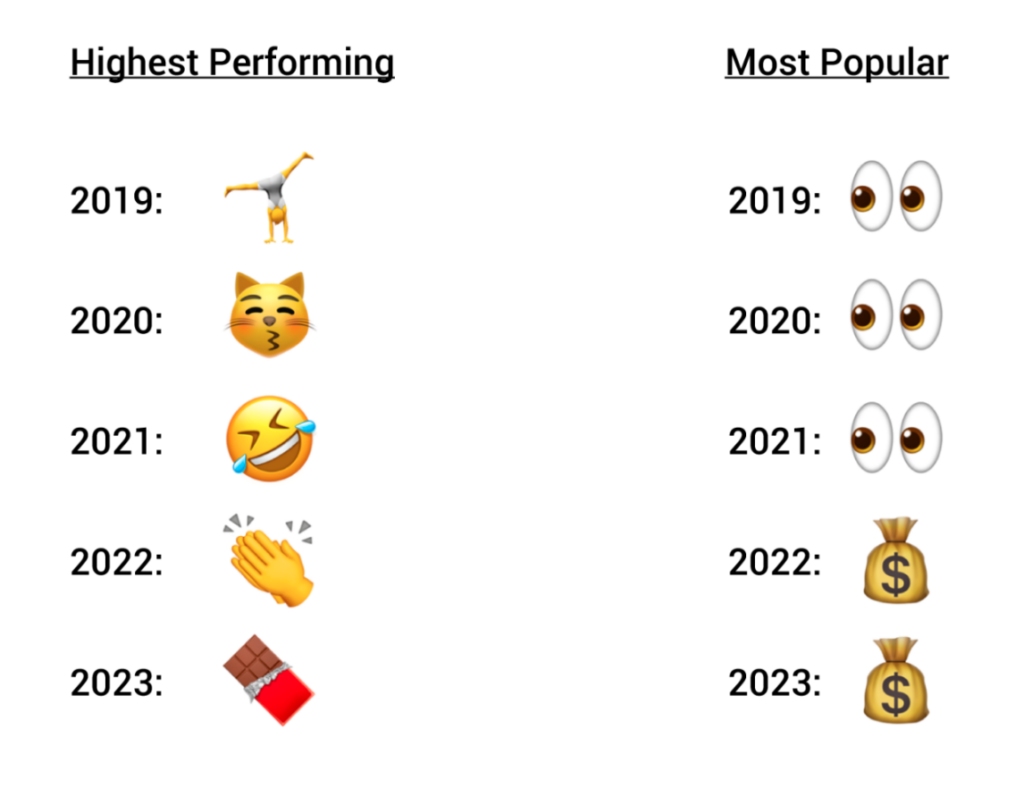Email Marketing
Emojis in Subject Lines: Do They Really Improve Email Performance?

Email Marketing

Since emojis first became popular in the 2010s, they’ve gone from millennial slang to a common form of linguistic expression. We’ve come a long way from simple emoticons like the smiley face 🙂 or frowny face :-(. In fact, Oxford Dictionary named the crying laughing face emoji (😂) “Word of the Year” in 2015. Emojis are everywhere, including in your email marketing campaigns.

I didn’t even have to search for these three to pop up together. Email marketers are all in on emojis. But do they actually help your email marketing performance, like increasing open rates? In this post, we’ll dive in to everything you need to know about using an emoji in your subject lines so you can breathe easy 😀:
When Apple first released the emoji keyboard in 2011 and they became more popular, marketers wrote them off as something exclusively for texting or for teens. Today, everyone uses them – and it’s general knowledge what each one stands for (and which ones to avoid…looking at you, 🍆). If you’re looking to stand out in the inbox and increase your open rates, a well-placed emoji is a good place to start. It’s a much easier way to evoke an emotion than with plain text.
Plus, emojis are just plain fun. In an inbox where you only have a few characters available to get your message across, why not use a shortcut that can make someone smile?
Just as marketing channels become less useful the more saturated they become, so too do email marketing strategies like this one. Now that everybody uses emojis, do they really help your email marketing metrics or lead to higher open rates?
Let’s take a look at the data:
Bottom line: Like everything in email marketing, the answer to this question is, “it depends.” A/B test your subject lines to figure out what works best for your audience. Your email list may be super into them – or not. The only way to know is to test with your target audience.
No, emojis aren’t likely to trigger spam filters. In fact, many of the things email marketers used to worry about aren’t much of a concern.
For example, you don’t have to be scared to use the word “free” or the occasional ALL CAPS in your subject lines. Spam filters have gotten much better at identifying real spammers, and that’s a good thing. Spam trigger words are mostly a myth, and so is the idea that emojis get you sent to spam.
It’s much more important to focus on things like email authentication and a strong sender reputation. You reputation as an email sender is partly based on your engagement rates. So, if your subscribers respond to emojis in subject lines – they may actually help you with inbox placement.
Technically, yes. Emojis are accessible to screen readers, which read the images out loud to anyone with visual impairments. This is similar to alt text in that it can convey the proper emotion and context.
Typically, screen readers read emojis like this:
But every program describes them differently, and if you use a long string of them (especially the same emoji over and over), it gets really annoying, really quickly. In the video below, a YouTuber with a vision impairment shows us how her iPhone interprets a wide variety of emojis.
If you want to use emojis in your subject lines, make sure to include actual text, too. And watch your emoji placement, too – throwing emojis in the middle of your message may dilute the meaning for folks using screen readers or make it difficult for them to get to your call-to-action.
You can use an emoji in your email marketing campaigns anywhere you can type one! This includes subject lines, but also preheader text, body copy, or your CTA. You can even use them to keep readers guessing, like this email from Penguin Random House:
That said, emojis are best used sparingly. While you can type them just as you would normally into a subject line field, think about what’s going to grab attention. If you’re interested in adding emojis into your emails, the simplest way is to copy and paste them straight into your code. You can find a full list of emojis here on Emojipedia.
Major email clients and mailbox providers do support emojis…but not the way you think. Some don’t support every single emoji that’s out there, and emojis will look different based on the different devices, email clients, and operating systems. For example, Windows 7 and earlier won’t show emojis, but Gmail always will. And brand new emojis take time to be picked up by different email clients.

The Unicode encoding known as UTF-8 is the most popular and reliable way to define special characters and symbols on the web and in emails as well as other forms of electronic communication. You can set your entire email to use UTF-8 character encoding. This tells ESPs, servers and email clients how the characters in your email will be encoded. Character encoding is a link between the visual representation of a character (like a registration mark or em-dash) and the bytes that store them in memory. You can set this in the code of your email header:
Date: Wed, 15 Dec 2021 12:45:55 -0700
To: test@test.com
From: testfrom@test.com
Subject: UTF-8
Message-ID: <e06deabc923f3378e4b237a20be324cc@www.test.com>
X-Priority: 3
X-Mailer: EOAMailer 5.0.0
MIME-Version: 1.0
Content-Transfer-Encoding: 8bit
Content-Type: text/html; charset="UTF-8"
Luckily, more and more email clients and operating systems support emojis these days.
One last element to keep in mind: Emojis take up more visual space than a traditional character, especially on mobile devices. Adding emojis to your email subject line may mean cutting off your message – another +1 for using emojis in the middle of your message carefully.
Before you dive in to a few subject line ideas, remember to put yourself in the shoes of your audience. The most popular emojis – and the ones you likely use on a regular basis – aren’t necessarily the ones that perform the best in A/B tests. According to Phrasee, these are the top performing emojis to choose from:

Here are a few ways you can incorporate emojis into your subject lines:
Your use of emojis matters. If you’re running a holiday campaign or season-specific promotion, adding an emoji here or there can be a great way to emphasize it for ecommerce brands, especially at the beginning or end of your subject line:





Emojis are, well, emotional. You can use a variety of different emojis to evoke similar, or the same emotion. If you’re looking to elicit an emotional reaction, set the tone for your newsletter, or showcase how a subscriber should feel about your email, an emoji does the trick. As the kids say, vibes.



Emojis can bracket your email’s subject line in a way that draws major attention to it. If you’ve got big, exciting news like a product launch and want the world to know – or if you want to generally create a sense of urgency, emojis make your email stand out in a crowded inbox.



Emojis give you a chance to add imagery into your subject line, which means you can help subscribers visualize new products or features before they even open your email. This won’t always translate – and you don’t want to do too many emojis where it becomes a guessing game – but can be a great way to mix up traditional product-driven campaigns.



Tap into the whimsical nature of emojis by using them to add a little humor to your subject lines. The more pun-tastic, the better. While you don’t want to have puns for every single email you send, an emoji can be enough to bring a smile to your subscriber’s face – and get that open.




If you’re interested in adding a little flair to your next email campaign, don’t forget to test. Sinch Email on Acid gives you a streamlined way to test for emoji support, including email encoding, deliverability, inbox display, Outlook rendering issues, dark mode emails, and more.